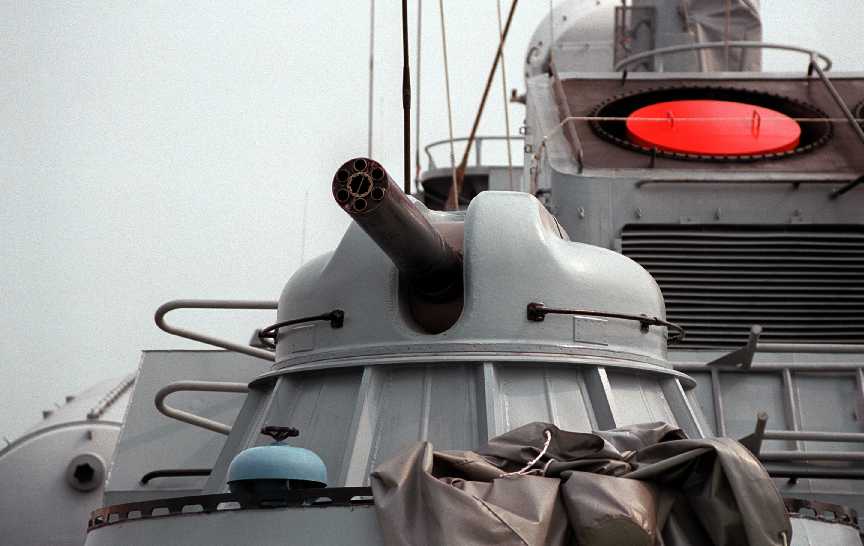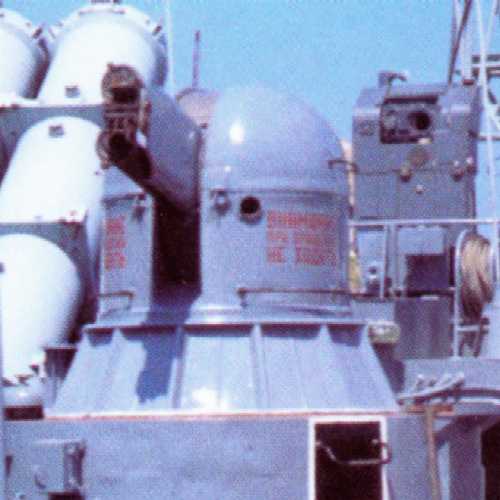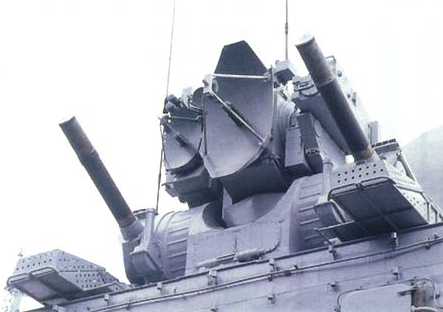Design of the AK-630 (A-213) gun system started in 1963. The first prototype was made in 1964 and trials were conducted until 1966. The trials of the complete system with radar and controls went on until 1976 when the system was accepted for service. Production started in 1969 in Tula, with a modified AK-630M (A-213M) system accepted into service in 1979. These systems are the main close-in defense systems on modern Russian ships.
The gun itself is a 6 barrel Gatling gun designated as AO-18. The barrels are in a single block, having exhaust-driven joint automatics. They are belt fed with a flat magazine in the AK-630 and a drum magazine in the AK-630M. These weapons form a part of a complete self-defense system called A-213-Vympel-A, which includes gun, radar, optical and TV control systems. A single MP-123 Vympel system can control two 30 mm guns or one 30 mm and one 57 mm gun. This system can engage air targets at ranges up to 4,000 m (4,400 yards) and surface targets at ranges up to 5,000 m (5,500 yards). The TV control system can detect MTB sized ships at the distance of 75 km (40 nm) and the fighter-size air targets at 7,000 m (7,600 yards). This system is completely automatic and does not require human supervision although it can be directed from optical control posts in case of damage or for firing on shore targets.
The AK-306 (A-219) system was a modification of the AK-630 (A-213) system for use on light ships, like air cushion craft, ekranoplanes and small displacement motor boats. Externally, there was no difference between AK-306 and AK-630 guns, but internally instead of using the exhaust to power the automatics, the AK-306 (A-219) used electricity. This version also lacked radar control, being only optically guided, hence making it less of a anti-missile weapon and more of a surface-to-surface weapon. The design started in 1974 and the system was accepted into service in 1980. By 1986, 125 systems were in service.
In 1983 a decision to modify the AK-630 systems was made and the design of the AK-630M1-2 "Roy" system started. This weapon uses two AO-18 six barrel blocks, placed one above the other, and its size and weight allowed it to be placed in existing AK-630 positions. The system was tested from 1984 to 1989, but, due to the appearance of the gun-missile systems, it was not put into production. The single example remains installed on the P-44 (Pr. 206.6) missile boat.
In the end of the 1970s the design of the gun-missile system 3M87 "Kortik" was started. This model uses two AO-18 six-barrel blocks and eight 9M311 missile launchers. Unlike the AK-630, the ammunition is not stored under the mount, but in drums next to the barrels. The Kortik control system can control from one to six mounts and has both radar and optical-TV controls. The missiles are supposed to engage targets from 1,500 to 8,000 m (1,600 to 8,750 yards) with the guns taking over at shorter ranges. The missiles weighs 43.6 kg (96 lbs.) each and have a lethal radius of 5 m (16 feet). The trials of the mount started in 1983 and the weapon was accepted into production in 1989 and was installed until 1994. At first, it was intended to replace all of the AK-630 mounts with 3M87 mounts, but the 3M87 was significantly larger and taller than the AK-630 which limited its use to ships that could handle the extra mass.
In the 1990s a new system was started using two AO-18KD six-barrel blocks and eight missiles. It was at different times called Palash or Palma and is currently offered for export sales. This system can use any type of small heat-seeking missiles such as Strela-10, Igla, Stinger and Mistral. It can also use the hyper-velocity laser guided Sosna R missiles. However, with the current state of the Russian economy, it is unknown if the system will ever go into production.
At this moment there are many modernization projects for AK-630, 630M and 306 systems pending, mostly by adding missiles to the sides of the systems. These are aimed for export sales.
| Designation | 30 mm/54 (1.2") AO-18 |
|---|---|
| Ship Class Used On |
|
| Date Of Design | 1963 |
| Date In Service | AK-630: 1976 AK-630M: 1979 AK-306: 1980 3M87: 1989 |
| Gun Weight | AO-18 (for AK-630): under 452 lbs. (under 205 kg) AO-18L (for AK-306): 341.7 lbs (155 kg) GSh-6-30K (for AK-630M1-2): 352.5 lbs. (160 kg) |
| Gun Length oa | 64.13 in (1.629 m) |
| Bore Length | 63.78 in (1.620 m) |
| Rifling Length | 57.48 in (1.46 m) |
| Grooves | 16 |
| Lands | N/A |
| Twist | N/A |
| Chamber Volume | N/A |
| Rate Of Fire | AK-630: 4,000 - 5,000 rounds per minute AK-630M: 4,000 - 5,000 rounds per minute AK-630M1-2: 10,000 rounds per minute AK-306: 600 - 1,000 rounds per minute 3M87: 10,000 rounds per minute Palash: 1,000 rounds per minute |
| Type | Fixed |
|---|---|
| Weight of Complete Round | 1.834 - 1.839 lbs. (0.832 - 0.834 kg) |
| Projectile Types and Weights | HE-FRAG (OF-84): 0.86 lbs. (0.39 kg) FRAG tracer (OP-84): 0.86 lbs. (0.39 kg) |
| Bursting Charge | HE-FRAG (OF-84): 0.107 lbs. (0.0485 kg) FRAG tracer (OP-84): 0.026 lbs. (0.0117 kg) |
| Projectile Length | up to 11.54 in (293 mm) |
| Propellant Charge | N/A |
| Muzzle Velocity | All: 2,953 fps (900 mps) 3M87: 2,822 fps (860 mps) Palash: 3,609 fps (1,100 mps) |
| Working Pressure | N/A |
| Approximate Barrel Life | AK-630: 8,000 rounds (automation resource) AK-306: 18,000 rounds |
| Ammunition stowage per gun | AK-630: 2,000 rounds AK-630M: 2,000 rounds AK-630M1-2: 4,000 rounds AK-306: 500 rounds |
| Elevation | Distance |
|---|---|
| Max Ballistic Range | 8,860 yards (8,100 m) |
| Self Liquidation range | 5,470 yards (5,000 m) |
| Effective Targeted Range | 4,375 yards (4,000 m) |
| Designation | Single Mounts: AK-630, AK-630M, AK-306 Twin Mounts: AK-630M1-2 Twin Gun-Missile Mounts: 3M87, Palash |
|---|---|
| Weight | AK-630 (empty): 4,079 lbs. (1,850 kg) AK-630 (with ammo): 4,226 lbs (1,918 kg) AK-630 (with control systems): 20,093 lbs. (9,114 kg) AK-630M1-2 (empty): 5,512 lbs. (2,500 kg) AK-630M1-2 (with ammo and control systems): 26,056 (11,819 kg) AK-306 (empty): 2,425 lbs. (1,100 kg) AK-306 (with ammo and control systems): 3,594 lbs. (1,630 kg) 3M87 (with ammo and control systems): 34,172 lbs. (15,500 kg) Palash (with ammo and control systems): 15,212 lbs. (6.900 kg) |
| Elevation | AK-630: -12 / +88 degrees AK-306: -12 / +85 degrees AK-630M1-2: -25 / +90 degrees |
| Elevation Rate | 50 degrees per second |
| Train | -180 / +180 degrees |
| Train Rate | 70 degrees per second |
| Gun recoil | AK-630: 0.51 in (13 mm) |
Data from:
- "The Naval Institute Guide to World Naval Weapon Systems 1991/92" by Norman Friedman
- "Etsiklopediya Otechestvennoi Artillerii" (Encyclopedia of Fatherland (Russian) Artillery) by A.V. Shirokorad
Special help from Vladimir Yakubov



